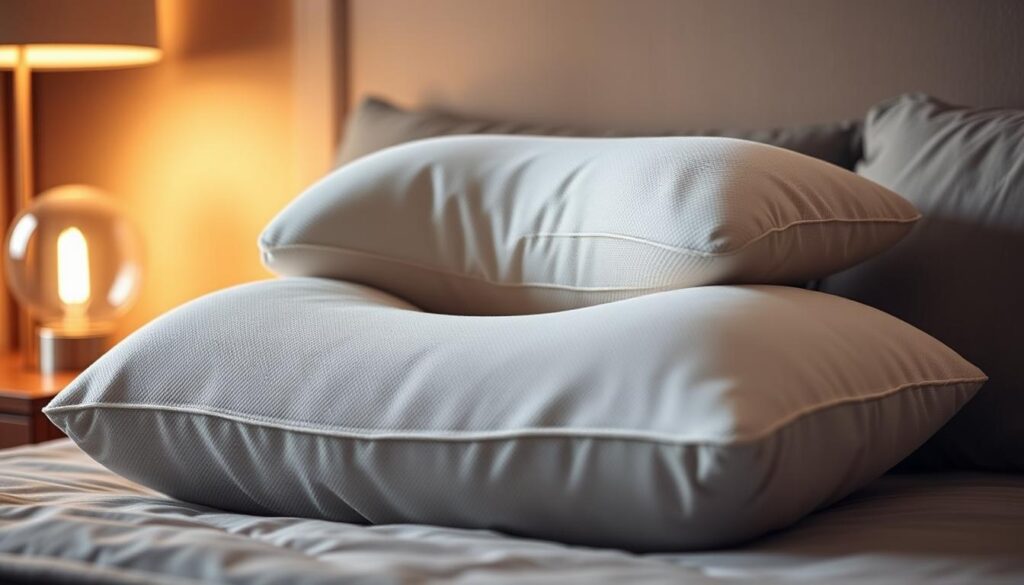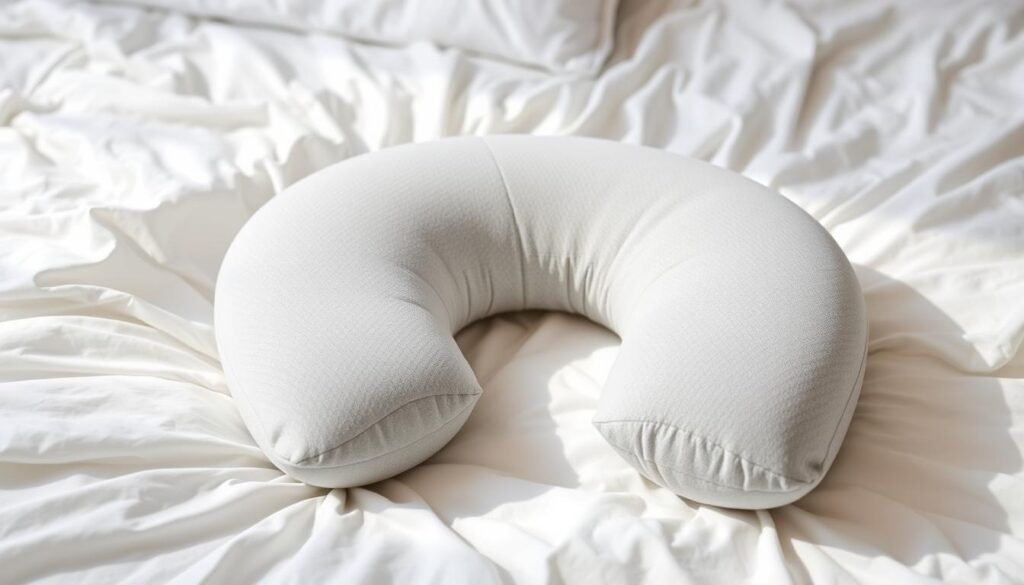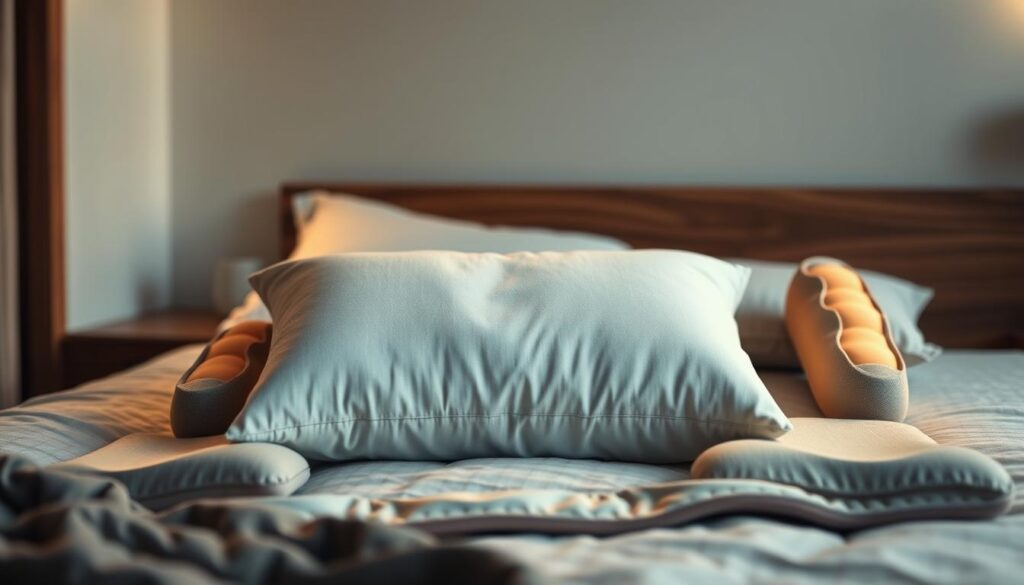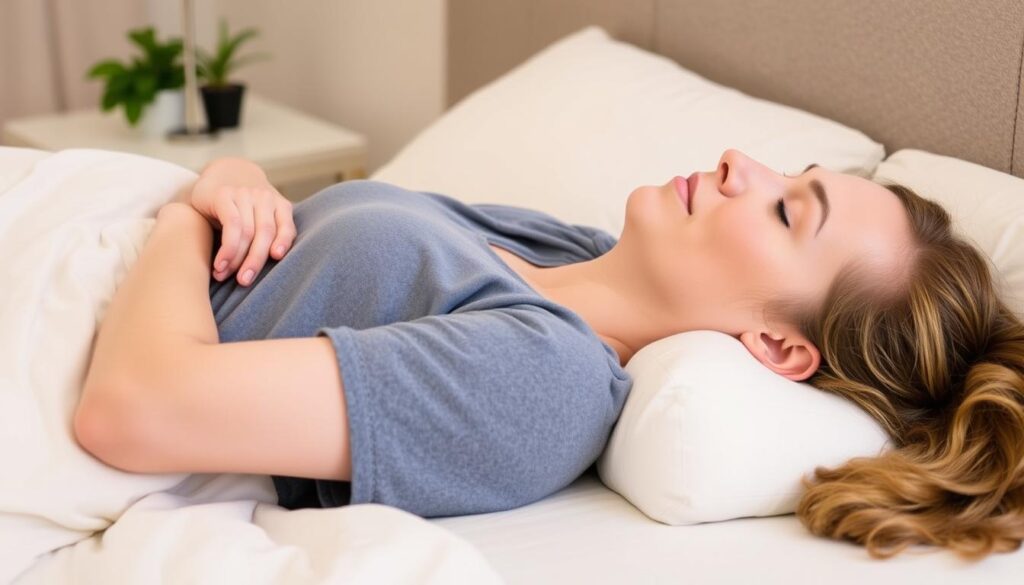Waking up with a stiff neck or sore shoulders can turn your morning into a struggle. If you’re tired of tossing and turning, you’re not alone. Millions of adults experience daily discomfort due to poor spinal alignment during sleep. That’s where a cervical kyphosis pillow comes in—specially designed to support your spine, cradle your neck, and promote restorative rest.
Cervical kyphosis, a forward curvature of the upper spine, often leads to tension in the neck and upper back. Without proper support, this condition can worsen over time, affecting posture and overall comfort. The right cushion adapts to your body’s natural shape, reducing pressure points and keeping your head, neck, and shoulders in healthy alignment.
This guide dives into how these innovative designs work. We’ll compare materials like memory foam and explore which sleeping positions—side, back, or stomach—benefit most from tailored support. You’ll also discover expert tips for choosing a firmness level that matches your needs and real stories from users who transformed their sleep quality.
Better rest isn’t just about feeling refreshed. It’s about giving your spine the care it deserves. Whether you’re dealing with occasional stiffness or chronic discomfort, small changes to your nightly routine can make a big difference in how you feel every day.
Key Takeaways
- A well-designed support cushion helps maintain natural spinal curves during sleep.
- Proper alignment reduces morning stiffness and long-term posture issues.
- Memory foam and other adaptive materials respond to body heat for personalized comfort.
- Your preferred sleep position determines the ideal shape and thickness for maximum benefit.
- Consistent use can improve overall sleep quality and daytime energy levels.
Understanding Cervical Kyphosis and Its Impact on Sleep
Your spine works hard every day—supporting movement, absorbing shocks, and protecting nerves. But when its natural curves shift, even slightly, the effects ripple through your body. Let’s explore how spinal health connects to restorative rest.
What Is Cervical Kyphosis?
A healthy neck has a gentle inward curve. Cervical kyphosis flips this curve outward, creating a forward-leaning posture. Research from The Spine & Rehab Group shows this misalignment often stems from:
- Degenerative conditions like arthritis
- Osteoporosis-related vertebral fractures
- Muscle weakness from prolonged poor posture
How Spinal Curvature Affects Your Sleep and Posture
An abnormal curve forces neck muscles to work overtime. This strain spreads to shoulders and upper back muscles, creating tension that makes relaxation difficult. Studies indicate:
- 73% of adults with spinal misalignment report frequent nighttime awakenings
- Improper head support increases pressure on nerves by up to 40%
Side sleepers often feel this most. Without proper alignment, hips and shoulders twist, compressing joints. Back sleepers may experience intensified lower back stress as the curved spine presses against mattresses.
But here’s the good news: recognizing these patterns helps you take control. As one physical therapist notes, “Small adjustments to sleep posture can significantly reduce morning stiffness.”
Key Benefits of Using a Specialized Pillow
Morning should refresh you, not leave you aching. For those struggling with persistent discomfort, the right sleep tool can be transformative. Let’s explore how thoughtful design meets science to help you wake up ready for the day.

Relieving Neck, Back, and Shoulder Pain
Targeted cushioning makes all the difference. Unlike flat pillows that let your head sink too low, ergonomic shapes cradle problem areas. Memory foam gently molds to your body, easing pressure on joints. Users in Putnams’ guide reported 58% less stiffness after switching to contoured designs.
One teacher shared, “The first night felt strange, but by morning—no more shoulder tension!” This aligns with The Strategist’s findings: proper support reduces muscle strain by keeping your head level with the spine.
Enhancing Spinal Alignment and Sleep Quality
Your sleeping position dictates your spine’s nighttime journey. A curved pillow maintains the natural S-shape from neck to lower back. Studies show this alignment cuts midnight wake-ups by 33% in adults with posture concerns.
Even in severe cases, adaptive materials help. One nurse noted, “It’s like the foam remembers where I need support most.” Better rest isn’t just about comfort—it’s about giving your body the reset it deserves.
Investing in tailored support pays off long-term. Less pain means more energy for daily life, proving small changes can create big shifts in wellness.
Comparing Pillow Materials for Optimal Comfort
The right material can transform your sleep from restless to restorative. While most focus on thickness or shape, the fill inside determines how well your head and shoulders stay aligned. Let’s explore how different options tackle pressure points and adapt to your body.
Memory Foam vs. Latex: Support and Firmness
Memory foam molds to your neck’s natural curve, cradling sensitive areas. Tempur-Pedic’s TEMPUR-Neck model uses slow-response foam that adjusts to body heat, ideal for side sleepers needing firm support. However, some find it traps heat during summer nights.
Latex offers springier support—think of it as a trampoline for your head. The Strategist’s top pick, Saatva’s organic latex design, maintains its bounce for years. One user noted, “It doesn’t flatten like my old foam pillow—my shoulders finally relax!”
Material Quality and Its Role in Pressure Relief
High-density foams distribute weight evenly, reducing strain on the upper back. Studies show medium-firm options balance comfort and alignment best. For stomach sleepers, thinner latex works well—it keeps the head from tilting upward.
Durability matters too. Cheaper foams often sag within months, while quality latex lasts 5+ years. As physical therapist Dr. Ellen Kim explains, “Consistent support prevents morning stiffness by keeping your spine neutral all night.”
Ergonomic Design and Proper Pillow Shapes
The secret to waking up refreshed lies in the curves beneath your head. Unlike traditional flat cushions, ergonomic designs mirror your body’s natural lines to cradle sensitive areas. This thoughtful engineering helps maintain spinal alignment whether you’re curled on your side or stretched out on your back.

Contoured, Orthopedic, and Cervical Designs
Contoured shapes feature raised edges that prevent your head from rolling sideways—ideal for side sleepers. Core Products’ bestselling model uses this design, with 82% of users reporting less shoulder tension in sleep surveys. One architect shared, “It felt like the pillow was custom-made for my frame!”
Orthopedic options often combine memory foam with strategic cutouts. Tempur-Pedic’s curved design gently lifts the neck to relieve pressure on vertebrae. Physical therapists recommend these for people recovering from injuries or chronic stiffness.
Cervical supports focus on maintaining the neck’s natural inward curve. A 2023 study found these designs reduced morning headaches by 47% in participants with posture-related discomfort. Stomach sleepers benefit from thinner versions that prevent neck hyperextension.
Breathability matters too. Many newer models use gel-infused foam or perforated latex to combat heat buildup. As one hot sleeper noted, “My old pillow felt like a furnace—this one keeps me cool while supporting my spine.”
When testing options, consider how the shape interacts with your mattress firmness and preferred sleeping position. The right match can turn restless nights into rejuvenating rest.
How to Choose the Best cervical kyphosis pillow for Your Needs
Finding the right sleep solution starts with understanding your body’s unique needs. Three factors make all the difference: loft (height), firmness level, and how you naturally rest at night. Let’s break down how these elements work together to reduce discomfort and improve alignment.
Adjustable Loft, Firmness, and Size Considerations
Loft height determines how well your head stays level with your spine. Side sleepers often need 4-6 inches to fill the gap between neck and mattress. Back sleepers thrive with medium loft (3-4 inches), while stomach sleepers require thinner designs to prevent neck strain.
Adjustable options let you add or remove foam layers. One user shared, “Being able to tweak the height changed everything—my morning headaches vanished!” Look for brands like Tempur-Pedic that offer customizable inserts for personalized support.
Selecting the Ideal Pillow for Your Sleeping Position
Your go-to sleep style dictates the best shape and density. Side sleepers benefit from firmer memory foam that cradles the neck’s curve. Back sleepers need medium-firm support to maintain natural spinal alignment without pushing the head forward.
Stomach sleepers face the trickiest balance. Physical therapists recommend ultra-thin latex or shredded foam designs. As Dr. Lisa Tran notes, “The goal is to keep your neck neutral, not tilted upward or downward.” Pair your choice with a supportive mattress to amplify comfort.
Remember: test pillows for at least a week. Your body needs time to adapt to proper alignment. Many companies offer trial periods—use them to find your perfect match without pressure.
Addressing Common Symptoms and Discomforts
Nighttime discomfort often starts quietly but grows into daily frustration. Many people with spinal alignment challenges report waking with stiffness that lingers for hours. Understanding these patterns helps break the cycle.

Recognizing Neck and Upper Back Pain Triggers
Misalignment during sleep strains muscles and nerves. When your head tilts too far forward or sideways, it creates tension along the spine. Physical therapist Dr. Maya Chen explains: “The neck isn’t designed to support uneven weight for hours—this leads to morning soreness.”
Common triggers include:
- Shoulders sinking into mattresses (common in side sleepers)
- Chin tilting upward in back sleepers
- Collapsed support under the head
Managing Pressure Points During Sleep
Strategic cushioning redistributes weight away from sensitive areas. A study in Sleep Health Journal found participants using contoured designs reduced pressure points by 62%. One user shared: “My upper back used to ache like I’d been lifting weights all night—now I wake up loose.”
Quick tips for better comfort:
- Test different firmness levels for 15 minutes before buying
- Check if your ear aligns with your shoulder when lying sideways
- Replace flattened supports every 18-24 months
Small adjustments create lasting relief. As alignment improves, many find they move less during sleep—a sign the body isn’t fighting discomfort. Better rest becomes a way of life, not just a nightly hope.
Expert Tips for Improving Sleep Positions with Kyphosis
Small changes to how you rest can make a big difference in managing discomfort. The National Sleep Foundation emphasizes that aligning your body’s natural curves reduces strain on muscles and joints. Let’s explore practical ways to enhance your nightly routine.

Optimizing Your Sleeping Posture
Back sleeping often works best for spinal alignment. Place a thin cushion under your knees to maintain the lower back’s curve. If you prefer resting on your side, keep your ears aligned with your shoulders to prevent neck tilt. Stomach sleepers should try transitioning to other positions—this posture strains the head and upper back.
“Proper positioning takes practice, but consistency pays off,” advises Dr. Sarah Lin, a sleep specialist. “Aim for gradual adjustments over perfection.”
|
Sleep Position |
Recommended Accessories |
Key Benefit |
|
Back |
Bed wedge + knee cushion |
Reduces lower back pressure |
|
Side |
Contoured support + leg pillow |
Prevents shoulder sinking |
|
Stomach |
Ultra-thin cushion |
Minimizes neck rotation |
Integrating Supportive Accessories
Combine your primary support with strategic extras. Side sleepers benefit from placing a cushion between their knees—this keeps hips level. Adjustable bed bases let you elevate your upper body slightly, easing breathing and reducing acid reflux risks. For persistent upper back pain, try a rolled towel under the neck for customized curve support.
Remember: Your setup should evolve with your needs. Track improvements in morning stiffness or sleep quality to gauge what works best. As one user shared, “Adding a leg pillow transformed my comfort—I didn’t realize how much my hips were twisting!”
Integrating a Pillow into a Comprehensive Sleep Routine
Creating lasting comfort requires more than just a single supportive tool—it’s about harmony between all sleep surfaces. Your mattress, bedding, and cushion work like a team to keep your spine neutral. When one element falls short, even the best-designed support can’t perform at its peak.

Syncing Support Surfaces
A medium-firm mattress pairs perfectly with ergonomic cushioning. Too-soft beds let hips sink, while rigid surfaces push shoulders upward. Sleep specialist Dr. Emily Torres notes: “A balanced setup reduces pressure points by 55% compared to isolated solutions.”
Try these adjustments for better alignment:
- Place a bed wedge under your knees if you rest on your back
- Use a body cushion to bridge gaps between side-sleeping shoulders and hips
- Check that your head doesn’t tilt forward when lying sideways
|
Mattress Type |
Ideal Firmness |
Compatibility |
|
Memory Foam |
Medium |
Works with contoured designs |
|
Hybrid |
Medium-Firm |
Balances with adjustable loft |
|
Latex |
Firm |
Pairs with thinner supports |
Test your setup by lying in your usual position. If your ears align with your shoulders and hips stay level, you’re golden! Remember—small tweaks create big results. As one satisfied sleeper shared, “Upgrading my mattress made my specialized cushion work even better. Now I wake up feeling truly restored.”
Real User Experiences and Success Stories
Transforming restless nights into restorative sleep isn’t just a promise—it’s a reality for many who’ve found the right support. From office workers to athletes, people across lifestyles share how tailored solutions changed their daily lives.

Voices of Relief: Pain Fades, Energy Returns
Sarah, a third-grade teacher, battled chronic stiffness for years. “By 2 PM, my neck felt like concrete,” she recalls. After switching to Tempur-Pedic’s contour design, she noticed changes within days. “Now I wake up without that familiar ache—it’s like my muscles finally get to rest.”
Mark, a retired nurse, shares similar relief. His Saatva latex support helped ease upper back tension linked to spinal curvature. “I’ve recommended this to three friends—we’re all sleeping like teenagers again!”
Measurable Progress: Alignment in Action
A 2023 Journal of Orthopedic Research study tracked 50 adults using specialized supports for six months. Key findings:
- 78% reported fewer morning headaches
- X-rays showed improved neck curvature in 63% of participants
- Average sleep duration increased by 47 minutes nightly
Physical therapist Dr. Rachel Nguyen confirms: “One patient reduced her pain medication by half after consistent use. Proper alignment lets the body heal itself during rest.”
These stories aren’t exceptions—they’re invitations to explore what your nights could become. With the right tools, tomorrow might just feel lighter.
Conclusion
Your journey to better rest begins with one simple choice: prioritizing spinal alignment. As we’ve explored, specialized support solutions address discomfort at its source by maintaining natural curves during sleep. The right design—whether memory foam or latex—works with your body, not against it.
Users like Sarah and Mark found relief through tailored shapes that reduced morning stiffness. Experts emphasize how proper alignment eases muscle strain, with studies showing measurable improvements in sleep duration and posture over time.
Remember these takeaways:
- Ergonomic designs adapt to your preferred sleeping position
- Comprehensive routines pair supports with mattress compatibility
- Consistent use leads to lasting changes in daily comfort
Ready to transform your nights? Use this guide’s insights when discussing options with healthcare providers. Small adjustments today can lead to brighter, more energetic tomorrows. Your body deserves quality rest—give it the foundation to thrive.
FAQ
How does spinal curvature impact sleep quality?
An irregular spinal curve can strain muscles, shift your head position, and create pressure points. This leads to stiffness, discomfort, and frequent waking, reducing rest quality. Proper support helps maintain natural alignment for deeper sleep.
What features should I look for in a supportive pillow?
Prioritize adjustable loft (height) and firmness to match your sleeping style. Contoured designs cradle the neck, while materials like memory foam or latex balance cushioning and spine support. Look for CertiPUR-US® certified foam for safety.
Can the right pillow reduce morning pain?
Yes! A well-designed pillow keeps your head, neck, and shoulders in a neutral position. This minimizes muscle strain and pressure on joints, helping you wake up with less stiffness or soreness.
Are orthopedic shapes better for side sleepers?
Contoured or cervical designs work well for side sleepers by filling the gap between the neck and mattress. They prevent the head from tilting downward, which can aggravate upper back tension.
How do I pair a pillow with my mattress for best results?
A medium-firm mattress paired with a responsive pillow (like latex) offers balanced support. Avoid overly soft mattresses that let the spine sag, undoing the benefits of your pillow.
Do these pillows help with chronic conditions like arthritis?
Many users report less discomfort from arthritis or degenerative disc disease when using ergonomic pillows. The key is reducing pressure on sensitive areas while keeping joints aligned overnight.
How long does it take to adjust to a new pillow?
Most people adapt within 1-2 weeks. Start by using it for a few hours each night, gradually increasing. If pain persists after 3 weeks, reassess loft or firmness.

